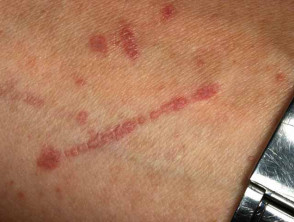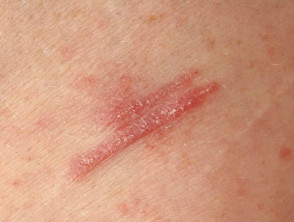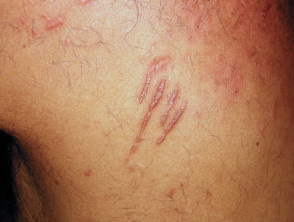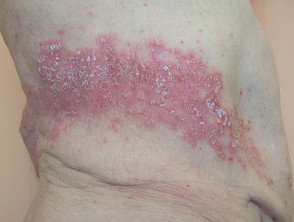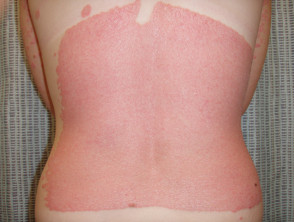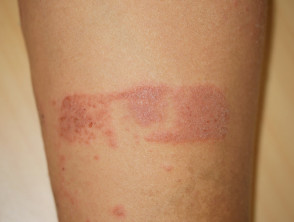What is the Koebner phenomenon?
The Koebner phenomenon describes the appearance of new skin lesions of a pre-existing dermatosis on areas of cutaneous injury in otherwise healthy skin. It is also known as the Köbner phenomenon and isomorphic response.
Linear lesions due to the Koebner phenomenon in lichen planus
What is the cause of the Koebner phenomenon?
The cause of the Koebner phenomenon is unclear. Current theories suggest the Koebner phenomenon requires both epidermis and dermis to be injured at the same site. The production of inflammatory substances and neuropeptides has been postulated as a non-specific first step, triggering a secondary disease-specific process. The role of chemical messengers such as nerve growth factor (NGF) may be important.
In what conditions is the Koebner phenomenon observed?
Skin conditions that regularly manifest Koebner phenomenon are psoriasis, vitiligo and lichen planus. There have been reports of possible Koebner phenomenon in many other conditions.
A true Koebner response occurs in:
A pseudo-Koebner response occurs with infections arising in an area of trauma, but represent transfer of virus into the damaged skin:
Localised trauma can also lead to:
- Behҫet disease and pyoderma gangrenosum (pathergy)
- Cancer, for example Marjolin ulcer arising in a longstanding scar
- Darier disease
- Erythema multiforme
- Granuloma annulare
- Hailey-Hailey disease
- Kaposi sarcoma
- Kyrle disease
- Lichen sclerosus
- Morphoea
- Necrobiosis lipoidica
- Pellagra
- Perforating folliculitis
- Reactive perforating collagenosis.
What are the triggers for the Koebner phenomenon?
A variety of skin injuries have been found to trigger the Koebner phenomenon.
Trauma
- Bites: animal, insects
- Burns: thermal, electrodessication, sunburn
- Excoriation, friction: shaving
- Freezing: cryotherapy
- Lacerations: gunshot, needle scarification, surgical incisions
- Pressure: orthotics, pressure sores, thumb-sucking, nail manicure
Chemical irritation
- A positive patch test reaction
- A tattoo-associated skin reaction
- BCG or influenza vaccination
- Hair spray or hair dye allergy
- Tuberculin skin test
- Iodine reaction
Diseases/medical conditions
- Urticaria
- A variety of inflammatory dermatoses
Other
- Phototherapy and sunburn
- High-energy irradiation
- Withdrawal of methotrexate therapy
How is the Koebner phenomenon diagnosed?
The Koebner phenomenon is diagnosed clinically. The characteristic lesions:
- Develop at sites of cutaneous injury (such as a scratch), in previously healthy skin
- Have the same clinical and histological features as lesions of the patient's original skin disease
- Are not due to the seeding of an infectious agent, an allergic reaction to a contact agent, or skin breakdown.
Lesions may form in patients with or without pre-existing skin conditions. A true Koebner response can be confirmed by experimentally reproducing lesions with different methods of injury. However, this may not always work and is not usually practical or desirable.
Koebner phenomenon lesions are typically linear in shape as they follow the route of cutaneous injury. Aside from linear skin injury, linear lesions arising from the Koebner phenomenon can also be seen in mosaic skin disorders (eg, segmental lichen planus).
What are the clinical features of the Koebner phenomenon?
Graded response to trauma
Patients differ in terms of how intensely they respond to skin injury.
- Maximal Koebner response: lesions develop across the entire injured area.
- Minimal Koebner response: a lesion develops in a focal area of trauma.
- Abortive Koebner response: lesions appear, but spontaneously vanish after 12–20 days.
- No Koebner response to injury.
All or nothing response
Patients who develop the Koebner phenomenon in response to one method of injury are susceptible to other triggering stimuli. This is particularly noted in patients with psoriasis. Conversely, a patient who does not develop skin lesions with one type of injury is not expected to exhibit the Koebner phenomenon with another type of injury.
Time to development of lesions
The time from injury to the formation of a skin lesion depends on the specific skin disease. For psoriatic plaques, it is between 10 to 20 days, with a range from 3 days to 2 years. The time to lesion formation can differ in the same patient.
Non-cutaneous Koebner phenomenon
Some reports suggest the Koebner phenomenon may affect other surfaces apart from the skin, such as the oral mucosa, or cause lesions in internal organs, such as the lungs after damage from chronic infection. Cutaneous lesions due to Koebner phenomenon have been reported in sarcoidosis and systemic lupus erythematosus.
What other phenomena are associated with cutaneous trauma?
Other phenomena in relation to skin trauma or inflammation are distinct from the Koebner phenomenon.
- The reverse Koebner phenomenon is the disappearance of a skin lesion after trauma to the area.
- Wolf's isotopic response is the emergence of a new dermatosis in the exact place of a previous unrelated dermatosis.
- Renbök phenomenon is the disappearance of an existing skin condition after the onset of a new dermatosis at the same site.
- Pathergy is an altered tissue reactivity in response to trauma, with the formation of papules or pustules.
Koebner phenomenon in psoriasis
Psoriasis is the best studied condition that exhibits the Koebner phenomenon and can be used to aid diagnosis.
Koebner phenomenon has been noted to be particularly prevalent in:
- Unstable psoriasis
- Patients with a young age of onset of psoriasis
- Patients who have received multiple treatments for psoriasis
- Winter, compared to summer
- Emotionally distressed patients.
Other studies indicate that the Koebner phenomenon:
- Occurs less frequently during remission from psoriasis
- Is not related to disease severity; it can occur in mild and severe disease.
Plaques due to the Koebner phenomenon can appear on any area of the body, even those not usually involved by psoriasis.
In recalcitrant psoriasis, a concurrent skin condition such as contact dermatitis may drive the disease via the Koebner phenomenon.
Koebner phenomenon in psoriasis
Can the Koebner phenomenon be prevented?
Although it is not possible to prevent all cutaneous injury, if you are susceptible to the Koebner phenomenon, take care to avoid:
- Sunburn
- Contact with irritants
- Scratching.
The following have been reported to prevent the Koebner phenomenon:
- Pressure, such as a pressure dressing or bandage
- Suction, such as a vacuum dressing
- A vasoconstrictor, such as adrenaline.
What is the treatment for Koebner phenomenon?
- Elective surgery/procedures are ideally performed while skin disease is stable or in remission.
- Active systemic treatment of psoriasis may suppress the Koebner phenomenon.
- A bland ointment may be inhibitory but topical corticosteroids have not been shown to prevent Koebner phenomenon.
Treatment for the cutaneous lesions arising from the Koebner phenomenon depends on the associated skin condition.
